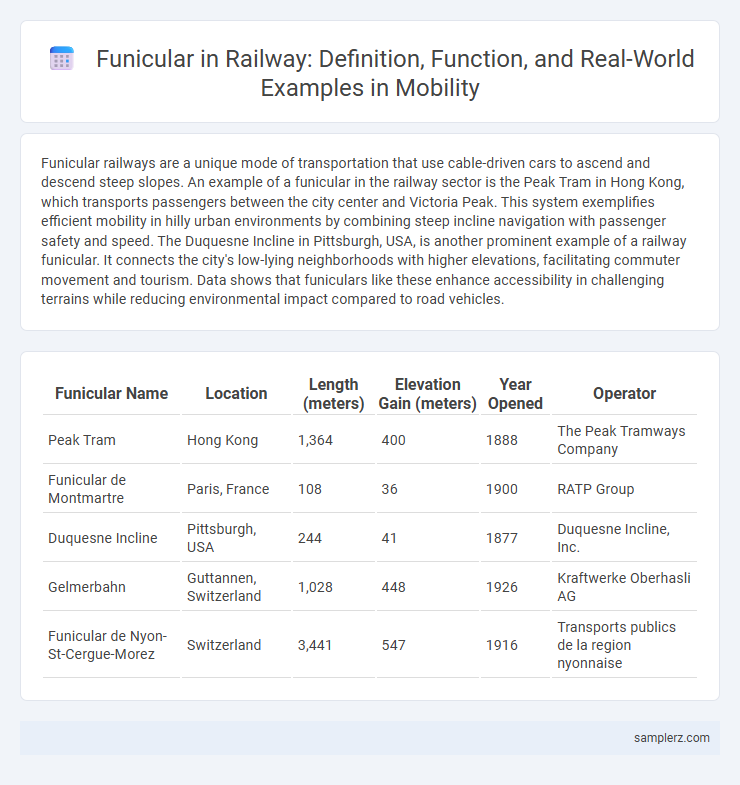Funicular railways are a unique mode of transportation that use cable-driven cars to ascend and descend steep slopes. An example of a funicular in the railway sector is the Peak Tram in Hong Kong, which transports passengers between the city center and Victoria Peak. This system exemplifies efficient mobility in hilly urban environments by combining steep incline navigation with passenger safety and speed. The Duquesne Incline in Pittsburgh, USA, is another prominent example of a railway funicular. It connects the city's low-lying neighborhoods with higher elevations, facilitating commuter movement and tourism. Data shows that funiculars like these enhance accessibility in challenging terrains while reducing environmental impact compared to road vehicles.
Table of Comparison
| Funicular Name | Location | Length (meters) | Elevation Gain (meters) | Year Opened | Operator |
|---|---|---|---|---|---|
| Peak Tram | Hong Kong | 1,364 | 400 | 1888 | The Peak Tramways Company |
| Funicular de Montmartre | Paris, France | 108 | 36 | 1900 | RATP Group |
| Duquesne Incline | Pittsburgh, USA | 244 | 41 | 1877 | Duquesne Incline, Inc. |
| Gelmerbahn | Guttannen, Switzerland | 1,028 | 448 | 1926 | Kraftwerke Oberhasli AG |
| Funicular de Nyon-St-Cergue-Morez | Switzerland | 3,441 | 547 | 1916 | Transports publics de la region nyonnaise |
Introduction to Funicular Railways
Funicular railways are cable-driven systems designed to transport passengers up steep inclines by using two counterbalanced cars connected by a cable. This method optimizes energy efficiency and safety on slopes that challenge traditional railways, with notable examples including the Peak Tram in Hong Kong and the Gelmerbahn in Switzerland. The engineering behind funiculars combines simple pulley mechanics with advanced control systems to ensure smooth, reliable operation on steep gradients.
Historical Evolution of Funicular Systems
Funicular systems, originating in the early 19th century, revolutionized steep terrain transport by using counterbalanced carriages connected by cables. The technology evolved from simple water-bucket mechanisms to advanced electric drives, enhancing efficiency and safety in urban and mountainous environments. Iconic examples like the Budapest Castle Hill and Pittsburgh Monongahela Incline exemplify the historical progress and enduring utility of funicular railways in mobility infrastructure.
Notable Urban Funicular Railways Worldwide
Notable urban funicular railways include the Carmelit in Haifa, Israel, recognized as the world's shortest subway-funicular hybrid, and the Peak Tram in Hong Kong, which transports passengers up Victoria Peak with panoramic city views. The Funicular dos Guindais in Porto, Portugal, connects the riverside area to the old town with a steep incline of 42%, while the Montmartre Funicular in Paris, France, serves as a popular tourist attraction linking the base of the hill to the Sacre-Coeur Basilica. These systems highlight the integration of funicular technology in varied urban landscapes to efficiently manage steep terrains and enhance city mobility.
Famous Mountain Funiculars for Tourists
Famous mountain funiculars attract millions of tourists annually by providing unique and scenic transport up steep terrains, combining engineering marvels with breathtaking views. Notable examples include the Gelmerbahn in Switzerland, known for its steep gradients and panoramic Alpine vistas, and the Peak Tram in Hong Kong, offering a historic route to Victoria Peak's skyline overlooks. These funiculars enhance mobility in mountainous regions while serving as iconic tourist attractions that blend transportation efficiency with cultural heritage.
Funicular Technology and Mechanisms
Funicular technology uses a cable traction system where two counterbalanced carriages are permanently attached to opposite ends of a cable, moving up and down steep inclines on parallel tracks. The mechanism relies on a pulley wheel at the top station, powered by an electric motor that regulates the speed and ensures synchronized movement, optimizing energy efficiency. Sophisticated braking systems and safety devices are integrated to maintain stability and prevent accidents on steep gradients in urban and mountainous railway networks.
Iconic Funiculars in Public Transportation
Iconic funiculars like the Peak Tram in Hong Kong and the Duquesne Incline in Pittsburgh showcase unique engineering solutions for steep urban terrains, enhancing public transportation networks by providing efficient and scenic commuter routes. These funicular railways combine cable-driven technology with passenger cars adapted to extreme gradients, offering reliable transit in hilly areas where traditional railways face limitations. Their integration into city transport systems exemplifies how funiculars contribute to sustainable urban mobility and tourism appeal simultaneously.
Safety Features Unique to Funicular Railways
Funicular railways incorporate advanced safety features such as automatic braking systems that activate if the cable tension drops or if the car exceeds designated speed limits, ensuring passenger protection. Redundant cable systems and fail-safe mechanisms prevent accidents in case of primary cable failure, offering enhanced reliability compared to traditional railways. Track design with rack rails and cogwheels provides additional grip on steep inclines, minimizing the risk of slippage and improving overall operational safety.
Sustainability and Environmental Benefits of Funiculars
Funicular railways offer a sustainable transportation solution by minimizing energy consumption through counterbalanced carriages that reduce power requirements. Their electric operation produces zero direct emissions, contributing to lower urban air pollution and noise levels compared to conventional vehicles. By efficiently navigating steep terrains without extensive road construction, funiculars preserve natural landscapes and reduce habitat disruption.
Economic Impact of Funicular Systems in Local Communities
Funicular systems stimulate local economies by attracting tourists and improving accessibility to hillside destinations, which boosts revenue for nearby businesses and hospitality sectors. The construction and maintenance of funiculars create jobs, fostering economic development and infrastructure investment in surrounding communities. Increased property values and enhanced public transportation options contribute to long-term economic growth and sustainable urban mobility.
Future Trends in Funicular Railway Development
Future trends in funicular railway development emphasize integration with smart city infrastructure, enhancing energy efficiency through regenerative braking systems and renewable energy sources. Advanced automation and real-time monitoring technologies improve safety and operational reliability, while innovative design approaches enable funicular systems to traverse increasingly complex urban landscapes. Emerging projects worldwide showcase these trends, positioning funiculars as sustainable, high-capacity solutions for next-generation urban mobility.

example of funicular in railway Infographic
 samplerz.com
samplerz.com